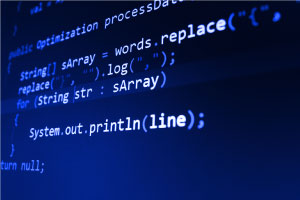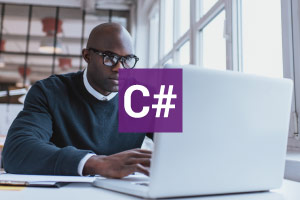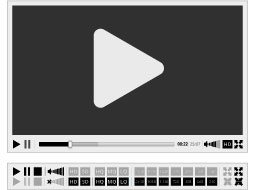Online courses directory (684)
What makes bioinformatics education exciting is that people of a variety of education levels can get started quickly, with just a computer and internet access.
Are you interested in learning how to program (in Python) within a scientific setting? This course will cover algorithms for solving various biological problems along with a handful of programming challenges helping you implement these algorithms in Python. It offers a gentler-paced alternative to the first course in our Bioinformatics Specialization (Finding Hidden Messages in DNA).
In computer science control flow is a very important concept to understand for the development of effective and efficient software programs. Control flow is the order in which individual statements, instructions, or function calls are executed within a piece of software. In this free online computer programming course you will learn more about the use of statements and logic in C programming. You will be introduced to conditional flow statements, the mechanisms for controlling flow statements, and how to implement simple statements in C. Logical operators such as OR, GOTO and the While loop are also discussed in detail. This free online computer programming course will be of great interest to all IT professionals who would like to learn more about the use of control flow when developing software using the C programming language, and to all learners who want to learn more about the procedures used to write effective software programs.<br />
C is a powerful system programming language and is commonly used to programme operating systems such as Unix. One of the main advantages of programming in C is that it allows the programmer to write directly to memory. This means that key constructs such as pointers, constants and strings can be used within the memory in an efficient and machine-independent fashion. This free online computer programming course covers topics such as using pointers for direct memory access and manipulation in C, changing the memory address contained within a pointer and introduces constants and string literals. You will learn why pointers contain memory addresses of multi-byte variables, and how to visualise RAM in a new way. This free online computer programming course will be of great interest to IT and software professionals who would like to learn more about this powerful and efficient programming language, and to all learners who would like to learn more about the kind of programming language that is used to develop operating systems.<br />
Modern society across the world is becoming increasingly dependent on communication networks. We depend on them for the smooth operation of economic and social activities. This course examines networks as the means of interconnecting devices so that two-way communication is possible. It examines protocols like HTTP, TCP/IP and ATM as well as the OSI reference model, and provides an overview of the topic for learners who have no significant prior knowledge of the subject. The main topics covered in this course are: Internet protocol (IP), the Open Systems Interconnection (OSI) model, Transmission Control Protocol (TCP), Hypertext transfer protocol (HTTP), and Asynchronous Transfer Mode (ATM). Areas that are also covered include the layers of communication, vertical and horizontal communication, protocol architecture, Domain name system, the ATM layers, and an analysis of IP over ATM. This course will be of interest to professionals who work in information technology, network design, and network management, and will also be of interest to students who would like a greater understanding of how networks function.<br />
The C programming language is one of the most popular and widely used programming languages and is commonly used to program operating systems such as Unix. It is a general-purpose programming language and one of the main advantages of programming in C is that it allows the programmer to write directly to memory. This means that key constructs within C-generated software programs can be used within the memory in an efficient and machine-independent fashion. <br /><br />ALISON's free online C programming Diploma course introduces you to the important concepts when programming in C. You will learn how the C programming language works with data, what program flow is, and how to use functions, methods and routines. You will be introduced to conditional flow statements, the mechanisms for controlling flow statements, and how to implement simple statements. Logical operators such as OR, GOTO and the While loop are also discussed in detail. The course covers topics such as using pointers for direct memory access and manipulation in C, changing the memory address contained within a pointer and introduces constants and string literals. You will learn why pointers contain memory addresses of multi-byte variables, and how to visualize RAM in a new way. You will also get step by step instructions on how to create simple C programs and how to run them. <br /><br />This free online C programming Diploma course will be of great interest to all IT, software and computer professionals who would like a greater knowledge and understanding of the C programming language and its key concepts and features, and to learners who would like to learn more about this widely used programming language.<br />
This Capstone MOOC gives Signature Track students who passed all previous MOOCs in the MoCCA Specialization “with Distinction” an opportunity to integrate and demonstrate the knowledge they've acquired across the three earlier content area MOOCs.
¿Alguna vez pensaste en crear tus propios juegos de computadora, pero no tenías idea cómo hacerlo o por dónde comenzar? Este curso te enseñará a programar utilizando Scratch, un lenguaje de programación visual muy fácil de usar, y más importante aún, aprenderás los principios fundamentales de la computación para que comiences a pensar como ingeniero/a de software.
本課程教授BIM技術的基礎知識,並以貼近實務之工程案例為教學範例,教授BIM塑模之基礎觀念與操作邏輯,並讓學生能實際應用BIM工具於案例實作中。
The Diploma in Information Technology Management is a free online course that explains why managers must understand how Information Technology plays a fundamental role in both the structure and control of the modern business. A successful manager must have an excellent grasp of the functionality, capabilities and effects of the technology that he or she must implement and manage. This free online course presents an array of the core concepts of Information Technology management. The course will review such key areas as corporate frameworks, software, databases, information systems, communications and management of personnel in relation to technology and from the point of view of the business manager. This course is ideal for management professionals who wish to gain an in depth understanding of the management of Information Technology in the modern corporation. The course is also ideal for those who would like to learn about the central role of Information Technology in today’s workplace.<br />
This free online Diploma in Multimedia Development course covers the skills and techniques needed to create professional-looking videos, visual effects, motion graphics and animations. The course offers a rigorous exploration of key multimedia tools including Adobe Photoshop, Windows Movie Maker, Adobe Flash, Audacity, Director MX and Adobe After Effects. <br /><br />The video-based tutorials are delivered in a non-technical and step-by-step manner by the award-winning multimedia teacher Russell Stannard. The Diploma course is ideal for those who want to gain a thorough knowledge and understanding of multimedia development tools and techniques and who want to enhance their career prospects in the process.<br />
Kursbeschreibung
Der Kurs führt in das zentrale Gebiet der Informatik ein, auf dem alle anderen Teilgebiete aufbauen: Wie entwickele ich Software? Anhand der Programmiersprache Java werden Algorithmen zum Suchen und Sortieren vorgestellt und die dazu benötigten Datenstrukturen wie Keller, Schlange, Liste, Baum und Graph eingeführt.
Was lerne ich in diesem Kurs?
Die Teilnehmer des Kurses werden in die Lage versetzt, eine Problemstellung auf maschinelle Lösbarkeit hin zu analysieren, dafür einen Algorithmus zu entwerfen, die zugehörigen Datenstrukturen zu wählen, daraus ein Java-Programm zu entwickeln und dieses zur Lösung des Problems einzusetzen.
Welche Vorkenntnisse benötige ich?
Mathematikkenntnisse auf Oberstufenniveau.
Kursplan
| Kapitel | Thema |
|---|---|
| Kapitel 1 | Einführung |
| Kapitel 2 | Systemumgebung |
| Kapitel 3 | Java |
| Kapitel 4 | Datentypen |
| Kapitel 5 | Felder |
| Kapitel 6 | Methoden |
| Kapitel 7 | Rekursion |
| Kapitel 8 | Komplexität |
| Kapitel 9 | Sortieren |
| Kapitel 10 | Objektorientierung |
| Kapitel 11 | Abstrakte Datentypen |
| Kapitel 12 | Suchbäume |
| Kapitel 13 | Hashing |
| Kapitel 14 | Graphen |
本課程教授BIM技術應用的基本知識及發展潛力,重點放在如何應用BIM資訊模型於實務工程中,包括設計衝突之檢討、工程數量之估算、工程進度之管理等應用。
本課程有兩大課程目標: 1. 使同學了解如何以搜尋達成人工智慧 2. 使同學能將相關技術應用到自己的問題上
Learn various methods of analysis including: unsupervised clustering, gene-set enrichment analyses, Bayesian integration, network visualization, and supervised machine learning applications to LINCS data and other relevant Big Data from high content molecular and phenotype profiling of human cells.
This is the second course in a two-part series on bioinformatics algorithms, covering the following topics: evolutionary tree reconstruction, applications of combinatorial pattern matching for read mapping, gene regulatory analysis, protein classification, computational proteomics, and computational aspects of human genetics.
This course is based on the work of the MIT-African Internet Technology Initiative (MIT-AITI). MIT-AITI is an innovative approach by MIT students to integrate computers and internet technology into the education of students in African schools. The program focuses upon programming principles, cutting-edge internet technology, free open-source systems, and even an entrepreneurship seminar to introduce students in Africa to the power of information technology in today's world.
MIT-AITI achieves this goal by sending MIT students to three African nations in order to teach both students and teachers through intensive classroom and lab sessions for six weeks. The AITI program is implemented with emphasis on classroom teaching, community-oriented projects, and independent learning.
This course has two major components:
- Content from a spring 2005 preparatory seminar offered by the MIT-AITI leadership. The goal of this seminar is to adequately prepare the AITI student teachers for their upcoming summer experiences in Africa.
- A snapshot of the summer 2005 MIT-AITI program. This includes the Java®-based curriculum that MIT-AITI ambassadors teach in Africa each year, as well as content from an entrepreneurship seminar offered concurrently with the IT class.
Can you make a cellphone change the world?
NextLab is a hands-on year-long design course in which students research, develop and deploy mobile technologies for the next billion mobile users in developing countries. Guided by real-world needs as observed by local partners, students work in multidisciplinary teams on term-long projects, closely collaborating with NGOs and communities at the local level, field practitioners, and experts in relevant fields.
Students are expected to leverage technical ingenuity in both mobile and internet technologies together with social insight in order to address social challenges in areas such as health, microfinance, entrepreneurship, education, and civic activism. Students with technically and socially viable prototypes may obtain funding for travel to their target communities, in order to obtain the first-hand feedback necessary to prepare their technologies for full fledged deployment into the real world (subject to guidelines and limitations).
Learn how to use the cloud and write programs for data analytics.























